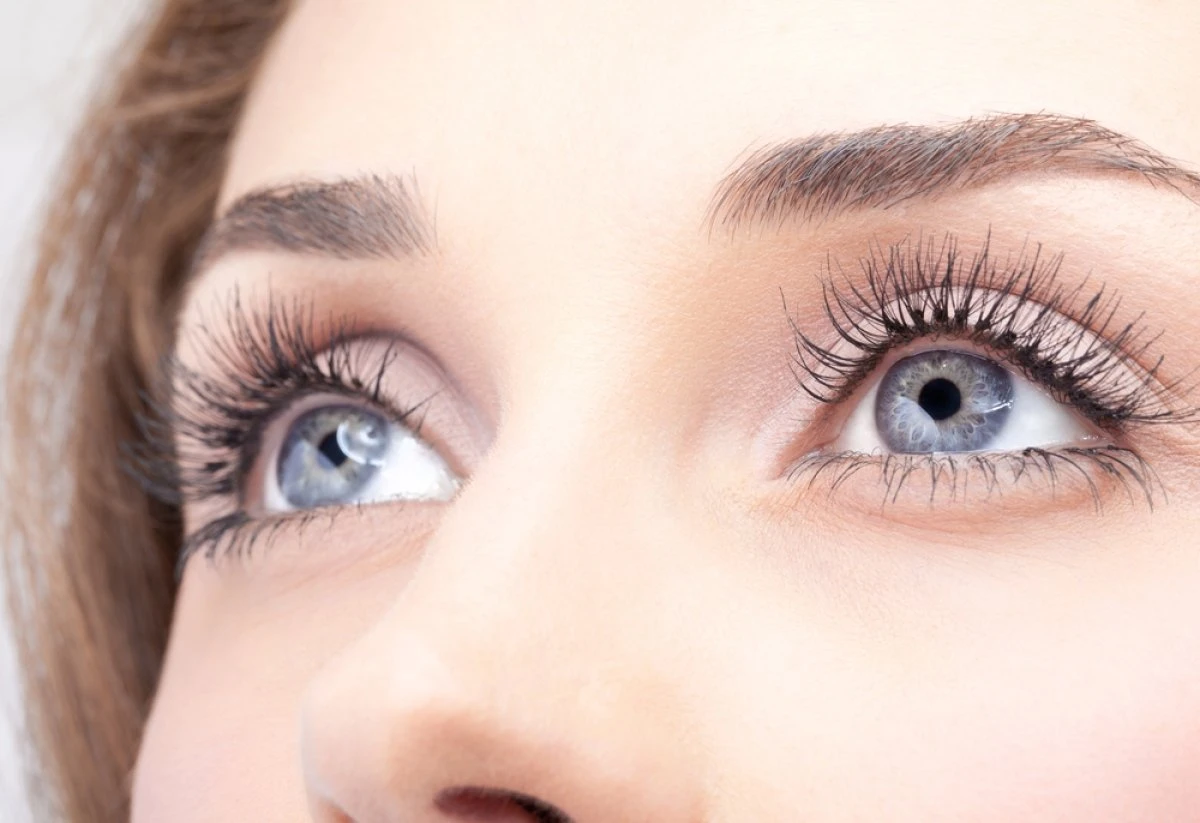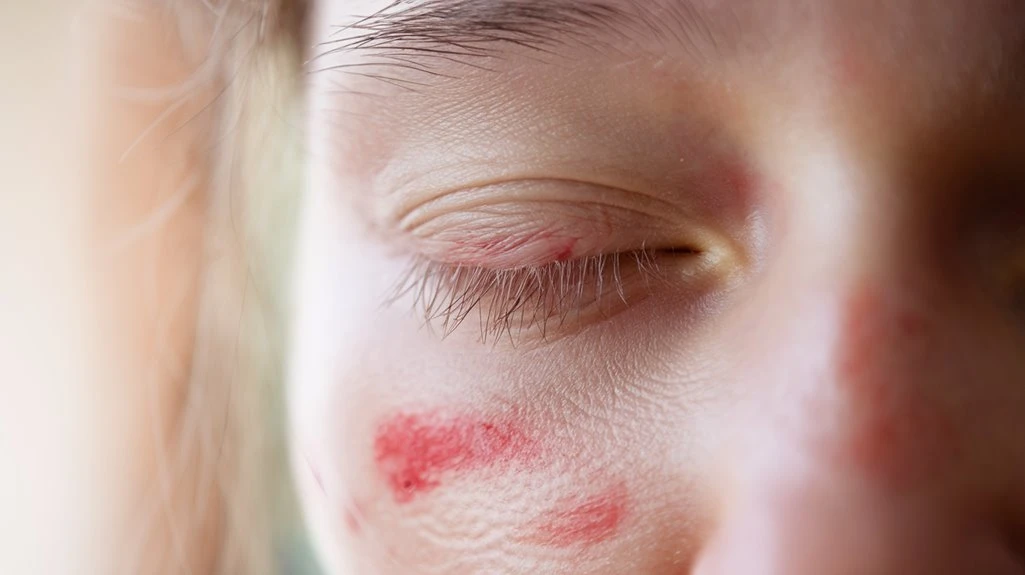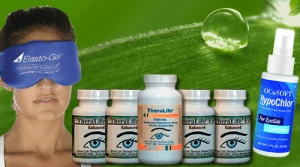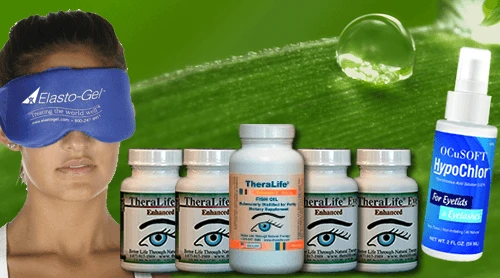When identifying rosacea eyelid inflammation, it’s important to recognize persistent redness and swelling along the lid margins, a gritty or burning sensation, and small papules or pustules near the lash line. Eyelid scaling, chronic eye irritation, and increased light sensitivity may also be present, while frequent tearing is less common. Differentiating these chronic, symmetrical symptoms from conditions like allergies or dermatitis is crucial.
TheraLife offers products that can benefit individuals experiencing these symptoms by providing relief from chronic eye discomfort and supporting eye health. Their natural, oral formulations aim to enhance tear production and reduce inflammation, potentially improving symptoms associated with rosacea and other eye conditions. By focusing on internal healing, TheraLife products strive to address the root cause of eye irritations and promote overall eye wellness.
TheraLife’s offerings include solutions for conditions such as blepharitis, dry eyes, and uveitis, among others. Their comprehensive approach incorporates dietary recommendations and natural treatments to support eye health holistically. With a focus on reducing dependency on eye drops and invasive procedures, TheraLife’s products are designed to offer a gentle, effective alternative for managing eye conditions.
Best Eyelid Inflammation Treatment From TheraLife- When Drops Don’t Work.
Key Takeaways
- Look for persistent redness and swelling along the eyelid margins, often accompanied by visible blood vessels.
- Note chronic gritty, burning, or foreign body sensations that don’t improve with standard lubricants.
- Check for fine scales or flaking at the eyelid edges, indicating ongoing eyelid inflammation.
- Assess for small bumps or pustules near the lash line, which are characteristic of rosacea-related eyelid involvement.
- Differentiate symptoms from allergies or dermatitis by noting their chronic, symmetrical, and persistent nature.
Recognizing Redness and Swelling of the Eyelids
Although rosacea often presents with facial flushing and visible blood vessels, redness and swelling of the eyelids—known as eyelid involvement or ocular rosacea—are less common initial symptoms.
You should carefully assess for eyelid color changes, particularly erythema or pinkness along the lid margins, as these may represent early inflammation. Inflammation causes local vascular dilation and increased permeability, producing both visible redness and subtle swelling.
Differential diagnosis includes blepharitis or allergic conjunctivitis, but persistent, symmetrical eyelid findings favor ocular rosacea. Hot compresses serve as a natural remedy to alleviate symptoms by unclogging meibomian oil glands and enhancing the effectiveness of other treatments. Examine the eyelid edges for thickening or telangiectasia, which are frequently documented in rosacea cases.
Early detection relies on recognizing chronic, non-resolving eyelid erythema and mild edema. These manifestations can precede more prominent cutaneous features, so a high index of suspicion is essential when evaluating patients with suspected rosacea.
Identifying a Gritty or Burning Sensation
When you evaluate patients, a persistent gritty sensation or burning feeling in the eyes is a key diagnostic clue suggesting ocular rosacea rather than generic dry eye or allergic conjunctivitis. This gritty sensation often presents as the feeling of sand or foreign material in the eye, while the burning feeling may be described as ongoing heat, irritation, or stinging. These symptoms tend to coexist with, or follow, eyelid erythema and edema characteristic of rosacea. Unlike seasonal allergies, ocular rosacea’s gritty and burning sensations are typically chronic and may not respond to standard lubricants alone. Ask targeted questions about chronicity, symptom triggers, and associated skin findings to improve diagnostic accuracy. Documentation of symptom persistence increases clinical suspicion. A burning sensation in the eyes could also indicate inflammatory mechanisms at play, as seen in conditions like blepharitis and dry eye disease.
Observing Eyelid Scaling or Flaking
In addition to persistent eye discomfort, clinicians should assess for eyelid scaling or flaking, which frequently occurs in patients with ocular rosacea. You may observe fine, white scales or desquamation along the eyelid margin. This manifestation often correlates with chronic inflammation of the meibomian glands, contributing to compromised eyelid hygiene. Warm Compresses can be an effective management strategy by improving meibomian gland function and reducing inflammation, which may alleviate symptoms. Evaluate whether the patient uses skincare products that might exacerbate irritation or disrupt the periocular microbiome. Document the presence and extent of scaling, as these features can help differentiate rosacea from other eyelid dermatoses, such as seborrheic blepharitis or atopic dermatitis. Encourage patients to maintain proper eyelid hygiene, as this measure supports disease management and improves clinical outcomes. Recognizing eyelid scaling provides essential diagnostic information when ocular rosacea is suspected.
Noting Persistent Eye Irritation or Discomfort
When evaluating rosacea, clinicians should note any reports of persistent eye irritation or discomfort, as these may represent early ocular involvement. If you experience chronic eye irritation—such as a burning, gritty, or foreign body sensation—it’s essential to recognize these as possible indicators of ocular rosacea. Eyelid discomfort can include a sensation of heaviness, soreness, or persistent redness along the lid margins. Document frequency, duration, and progression of these symptoms during assessment. Studies confirm that ocular manifestations often precede or accompany cutaneous changes in rosacea. You should ask patients targeted questions about recurring eye discomfort, as subtle signs may easily be overlooked. Early identification permits intervention, reducing the risk of complications like conjunctivitis or eyelid margin disease associated with rosacea inflammation. TheraLife Eye capsules are noted for reducing inflammation and aiding recovery from dry eyes, also addressing blepharitis and meibomian gland dysfunction.
Watching for Sensitivity to Light
You may notice photophobia, or increased sensitivity to light, as a diagnostic clue for ocular rosacea. Pay attention to any light-induced eye discomfort or strain during daily activities. It’s important to identify potential triggers, such as sunlight or bright indoor lighting, that worsen your symptoms. Implementing dietary adjustments and nutritional support, such as increasing Omega-3 intake, can help stabilize the tear film and reduce symptoms.
Recognizing Photophobia Signs
How does photophobia, or sensitivity to light, relate to rosacea symptoms? You may not realize that ocular rosacea often presents with photophobia as a primary clinical manifestation.
When evaluating for rosacea eyelid inflammation, note any reports of light sensitivity, particularly during disease flares. Evidence indicates that photophobia triggers include natural sunlight, fluorescent lights, and digital screens.
Patients frequently describe an urge to squint or shield the eyes, correlating with inflamed eyelid margins and meibomian gland dysfunction—hallmarks of ocular rosacea.
Diagnostic focus should remain on distinguishing persistent photophobia from transient discomfort. Document the frequency, intensity, and duration of light sensitivity.
If you consistently experience aversion to common lighting environments or changes in visual clarity under bright light, these signs may directly implicate underlying rosacea pathology affecting your eyelids. Ocular rosacea is a variant of the chronic skin condition rosacea, affecting the ocular region, and is often associated with symptoms such as redness and irritation.
Light-Induced Eye Discomfort
Light-induced eye discomfort frequently signals underlying ocular pathology in rosacea patients. When you experience light sensitivity, or photophobia, it’s important to assess whether this symptom accompanies eyelid redness, swelling, or irritation.
Evidence indicates that patients with ocular rosacea often develop heightened light sensitivity and eye strain due to chronic inflammation of the eyelids and ocular surface. You may notice increased blinking, difficulty focusing, or discomfort under fluorescent or natural light.
Clinically, the presence of persistent light-induced discomfort warrants a thorough ocular examination to evaluate tear film stability, eyelid margins, and conjunctival health. Recognizing these signs early supports the diagnostic process for ocular rosacea, ensuring timely intervention before secondary complications, such as corneal involvement or chronic dry eye, can develop and worsen your symptoms.
It is crucial to identify ocular rosacea symptoms early, as untreated cases can lead to serious complications, including corneal damage, underscoring the importance of medical evaluation and treatment.
Triggers for Increased Sensitivity
Beyond recognizing persistent photophobia, identifying specific environmental and lifestyle triggers often helps pinpoint patterns of increased sensitivity to light in rosacea. You should monitor how environmental factors and dietary influences affect your ocular comfort. Clinical observation suggests that flare-ups may closely coincide with particular triggers, and tracking these can inform your diagnostic assessment. Key aspects to monitor include:
- Environmental factors: Sudden changes in temperature, high humidity, or exposure to strong sunlight often intensify photosensitivity.
- Dietary influences: Spicy foods, hot beverages, and alcohol consumption can exacerbate vascular responses, leading to increased eyelid irritation.
- Lifestyle habits: Lack of eye protection, extended screen time, or inadequate blinking may predispose you to heightened photophobia.
Recognizing these correlations enables an evidence-based approach to therapeutic intervention and personalized management for rosacea-related ocular discomfort. Additionally, incorporating omega-3 fatty acid supplementation into your diet has been shown to improve meibomian gland function and reduce dry eye symptoms, thereby potentially alleviating some discomfort associated with rosacea.
Detecting Frequent Tearing or Watery Eyes
Clinically, frequent tearing or watery eyes do not indicate rosacea. If you notice persistent frequent eye watering, clinical evidence suggests it’s typically associated with alternate etiologies, most importantly allergy triggers or environmental irritants. Allergic conjunctivitis, for example, often presents with excessive lacrimation, itching, and chemosis—features distinct from classic rosacea manifestations. For accurate diagnostic differentiation, assess associated symptoms, onset triggers, and refractory response to antihistamine treatment. It is essential to maintain cleanliness of your eyelids and lashes to prevent infections.
Here’s a comparative symptom table:
| Symptom | Common Cause |
|---|---|
| Frequent tearing | Allergies, dry eye syndrome |
| Intense itching | Allergic conjunctivitis |
| Eyelid redness only | Possible rosacea, blepharitis |
| Stringy discharge | Allergic response |
| Gritty/sandy sensation | Dry eye, blepharitis |
Focus on systematic evaluation to prevent misattribution to rosacea.
Assessing the Presence of Small Bumps or Pustules
While frequent tearing points more toward allergic or environmental causes, evaluating the skin for small bumps or pustules offers critical diagnostic information for rosacea. You should perform a thorough small bump analysis on the eyelids, noting any discrete, dome-shaped papules or pustules clustered near the lash line. These features are hallmarks of rosacea-related eyelid involvement and are distinguishable from lesions seen with other dermatologic or ocular disorders. For effective pustule evaluation, carefully examine both the upper and lower eyelids for signs of focal erythema and raised lesion morphology. Use the following parameters to facilitate your assessment:
- Note lesion distribution and proximity to the eyelash margin.
- Identify the presence of erythema underlying or surrounding the bumps.
- Document lesion consistency—solid (papule) versus fluid-filled (pustule).
This targeted approach increases diagnostic accuracy for rosacea eyelid inflammation. It’s important to consider that Meibomian gland dysfunction is a primary cause of blepharitis, which may share some overlapping symptoms with rosacea, emphasizing the need for careful differential diagnosis.
Best Eyelid Inflammation Treatment From TheraLife- When Drops Don’t Work.
Differentiating Symptoms From Other Eye Conditions
How can you distinguish rosacea symptoms from those of other eye conditions? Start by focusing on chronicity and distribution.
Rosacea eyelid inflammation often manifests as persistent redness, telangiectasia, and occasional small pustules at the lid margin. In contrast, eyelid dermatitis typically causes diffuse swelling, scaling, and itching, linked to chemical irritants or frequent rubbing.
Allergy reactions present acutely, with pronounced itching, chemosis (conjunctival swelling), and watery discharge—features usually absent in rosacea. Also, in rosacea, you may notice a lack of trichiasis or significant mucous discharge compared to allergic or infectious etiologies.
Careful slit-lamp examination helps differentiate subtle findings, such as meibomian gland dysfunction in rosacea rather than the widespread inflammation seen in dermatitis.
Recognizing these clinical nuances optimizes diagnostic accuracy and targeted therapy.
Best Eyelid Inflammation Treatment From TheraLife- When Drops Don’t Work.
Frequently Asked Questions
Can Rosacea Eyelid Inflammation Affect My Vision Long-Term?
Rosacea eyelid inflammation, called ocular rosacea, can affect your long-term vision if left untreated.
Chronic inflammation effects may include meibomian gland dysfunction and corneal involvement, leading to dryness, irritation, and even corneal damage.
If inflammation persists, you might experience blurred vision or, in severe cases, vision loss.
Early diagnosis and management are essential to prevent these long-term vision complications.
Always seek prompt evaluation from an eye care professional for persistent symptoms.
Are Children or Teens at Risk of Rosacea-Related Eyelid Inflammation?
You should know that children and teens can develop rosacea-related eyelid inflammation, although it’s less common than in adults.
Childhood symptoms may include eyelid redness, irritation, and recurrent styes.
In teens, specific teen triggers like hormonal fluctuations or environmental stressors may induce or worsen ocular rosacea.
Clinically, early diagnosis is important since untreated inflammation can cause chronic eyelid changes or visual disturbance, so monitor and consult an ophthalmologist for proper evaluation.
What Lifestyle Changes Help Prevent Flare-Ups Around the Eyes?
To help prevent periocular rosacea flare-ups, prioritize dietary adjustments—limit spicy foods, alcohol, and caffeine, as studies link these to increased vascular reactivity.
Practice stress management techniques like mindfulness or cognitive behavioral therapy, since psychological stress can trigger inflammatory cascades.
Maintain consistent eyelid hygiene and avoid harsh cosmetics.
Document specific triggers in a symptom diary to facilitate diagnostic assessment by your ophthalmologist or dermatologist, allowing for individualized flare-up prevention strategies.
Is Rosacea Eyelid Inflammation Contagious to Others?
You don’t need to worry about spreading rosacea eyelid inflammation to others.
This condition isn’t considered a contagious skin condition, as there are no proven rosacea transmission risks between individuals.
Clinical evidence supports that rosacea, including ocular involvement, results from genetic and environmental factors rather than infectious agents.
You won’t transmit it via direct contact, shared towels, or personal items, so standard hygiene precautions are sufficient from a diagnostic perspective.
Which Medications Commonly Trigger Rosacea Symptoms Near the Eyes?
Imagine your eyelids feeling as if tiny sparks have started a quiet fire—certain medications can ignite rosacea symptoms there.
Common culprits include topical corticosteroids, some blood pressure medications (like beta-blockers), and vasodilators.
Antibiotic sensitivity, especially to tetracyclines, may also provoke flare-ups near the eyes.
Always monitor for medication side effects, report new ocular irritation, and pursue diagnostic evaluation to differentiate between medication-induced and primary rosacea-related inflammation.
Best Eyelid Inflammation Treatment From TheraLife- When Drops Don’t Work.
Conclusion
Identifying rosacea eyelid inflammation can be challenging, but certain symptoms provide important clues. Look for redness, swelling, persistent irritation, or tiny bumps. Additional signs like eyelid scaling, light sensitivity, and watery eyes can help distinguish rosacea from other ocular conditions. If you notice any of these symptoms, it is crucial to consult an eye care professional for a proper diagnosis and effective treatment.
Theralife’s products offer significant benefits for those experiencing ocular issues such as rosacea-related inflammation. The comprehensive approach includes natural supplements and targeted treatments that address the root causes of eye discomfort, promoting overall eye health. Theralife emphasizes evidence-based strategies to manage conditions like blepharitis, dry eyes, and eyelid inflammation, thus ensuring your eye health is not left to chance.





